Borg Refinery
Active member
On Tuesday, Jerome Powell’s Federal Reserve once again thumbed its nose at President Biden’s antitrust directive regarding the creation of more mega banks through merger. This time around, the Fed allowed the Bank of Montreal, with assets of $834 billion, and its subsidiary, BMO Financial, to gobble up Bank of the West, based in San Francisco. Following the merger, Bank of the West is to be merged into Bank of Montreal’s subsidiary bank, BMO Harris Bank.
On Friday, July 9, 2021, President Biden released a sweeping Executive Order that warned federal bank regulators against actions that create “excessive market concentration” with specific mention of bank merger activity. One business day later, the Federal Reserve announced that it had approved another bank merger.
According to the Fed’s own data, since January 1, 2006, it has approved 4,506 bank mergers, while denying one application. (See data here and here.)
At the end of 1999, the year that President Bill Clinton’s Wall Street-friendly administration repealed the 66-year old Glass-Steagall Act – ushering in an era where Wall Street’s trading casinos could buy federally-insured banks – the number of federally-insured banks and savings institutions has collapsed from a total of 10,220 to 4,746 as of September 30, 2022 according to data from the Federal Deposit Insurance Corporation. That’s a startling decline of 54 percent in banking competition.
But the decline in the number of overall banks fails to capture the magnitude of the concentration of assets at just four banking behemoths: JPMorgan Chase, Bank of America, Wells Fargo, and Citigroup’s Citibank. According to the September 30, 2022 report from the Federal Reserve, just four banks own $9.1 trillion in assets, or 39 percent of the total $23.6 trillion in assets owned by all 4,746 federally-insured banks and savings associations in the country.
To put it more starkly, those four banks represent just 0.08 percent of all the banks and savings associations in the United States while controlling 39 percent of the assets.
The largest bank in the United States by both assets and deposits, JPMorgan Chase, has racked up an unprecedented five felony counts from the U.S. Department of Justice for money laundering and rigging markets. Nonetheless, the Fed has allowed it to continually increase its footprint. JPMorgan Chase currently has 5,013 branch offices spread across 49 U.S. states according to the FDIC.
In short, the Fed has effectively seized control of the nation’s economic future, transferring wealth from the farms, small businesses and factory floors of America to the trading floors on Wall Street – which, not ironically, include two trading floors operated by the New York Fed. [..]
Our countries don't have free markets, everything is a complete monopoly.
